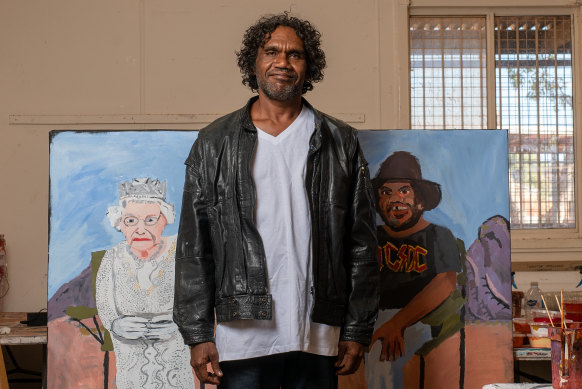- Dicey Topics
- National
- Good Weekend
This was published 6 months ago
‘Wow … It touched her’: Vincent Namatjira on that Gina Rinehart portrait
By Benjamin Law
Each week, Benjamin Law asks public figures to discuss the subjects we’re told to keep private by getting them to roll a die. The numbers they land on are the topics they’re given. This week, he talks to Vincent Namatjira. The painter, 41, was the first Indigenous artist to win the Archibald Prize in 2020. He received the Medal of the Order of Australia in honour of his contribution to Indigenous visual arts in the same year.

“That picture of Gina, that was just my way of seeing Australia’s richest person,” says Namatjira. “That’s straight from the heart.”
RELIGION
Did you grow up religious? Pretty much. Lutheran. There’s one particular church where my mother and my father were married – and where I was baptised – in Alice Springs. My father-in-law – now passed away – played guitar for the choir, and other family members were in the choir.
Is making art a spiritual experience? I see art as a bloodline through my great-grandfather to where I am today.
Is it true you grew up not knowing that your great-grandfather was the renowned painter Albert Namatjira? That’s correct. I didn’t know until I was 18. I found out through my relatives when I went back to Alice Springs from Perth, where I’d been to school.
Were you destined to be an artist as well? I think it’s more something to do with the path of a Christian life. You can choose the right path – or the bad path. There are a lot of paths to choose from. I chose the path that my great-grandfather had chosen.
What do you think happens after we die? We get reconnected to our ancestors or the Dream Time, that kind of thing. I’ll be a goanna. That’s my dreaming, my totem. So there’s a bit of half-and-half with tradition and religion there.
Who are your idols? One was my year 8 teacher, who taught me about sketching. We did this competition in class where we had to sketch the Endeavour and Captain James Cook. Whoever drew the best Endeavour would win a prize. All the kids drew it. I was one of ’em. My teacher picked mine up and said, “This is the one.”
What do you pray for? Tomorrow.
DEATH
You lost your mother, Jillian, in 1991. How did losing her at that young age change you? She’s pretty much been on my back and shoulders ever since, like a guardian.
You’ve always felt her presence, even as a kid? Pretty much. She’s saying, “Just keep going.” That’s what I feel. She’s always watching. Afterwards, as an Indigenous figure, I needed to take the opportunity – and my chance – to be someone better than the rest of our family, be a role model for them.
You spent a lot of your childhood away from your family in foster care – in Perth, for instance – only coming back to Central Australia at 18. Did reconnecting with your family feel like a rebirth? When everyone comes running out the house to meet you? Pretty much! “You was little baby and now you’re big little young fellow running around!” That kind of thing made me feel really happy.
They remembered you. Did you remember them? [Grins] A little bit. Just a pinch.
You’re the first Indigenous person to win the Archibald. Does that mean you can die happy now? No, I’ve still got a lot on my plate. I want to travel the world. At the moment, I’m thinking about Singapore and Hong Kong; I want to have exhibitions there. I also want to be a mentor for the younger generation. Teach the young fellas how to pick up a paintbrush and paint instead of getting into trouble.
When you die, is there one artwork you’ll be super-proud to be leaving behind? The one that hangs in the British Museum, with Captain James Cook, which was just received by the King.
MONEY
What’s it like to have a billionaire call for the removal of your portrait of her? To be honest, with that picture of Gina, that was just my way of seeing Australia’s richest person. That’s straight from the heart.
Did you expect her reaction? It didn’t bother me, really. That’s her opinion, her personal [reaction], her business. But for me to see that, it was like, “Wow, that painting really did affect someone. It touched her!” It jumped out from the canvas and acrylic and touched her.
When she made that request, did you feel flattered, insulted, intimidated? Or did you just find it funny? When the news came out that she wanted the portrait removed from the National Gallery, it was just like, “That’s up to her.” If she was painting me, I probably wouldn’t like it [either].
How much would she have to pay you to get that painting removed? Is there a figure? It’s pretty much not about money.
Even if she offered you a billion dollars? Pretty much! And I just sold it to the gallery anyway.
What did winning the Archibald mean to you? Fame.
What does fame give you? The opportunity to carry on the tradition of my great-grandfather, who was also a famous artist. Here I am today going the same way. I must run the same path – the right path, too.
If you weren’t making money as an artist, what would you be doing instead? Nothing much. Just playing sport.
What’s your most valued possession? My voice.
Why? Because I speak from the heart.
Namatjira’s exhibition, King Dingo, will be at the Ames Yavuz Gallery in Sydney, from August 31 to October 5.
diceytopics@goodweekend.com.au
To read more from Good Weekend magazine, visit our page at The Sydney Morning Herald, The Age and Brisbane Times.